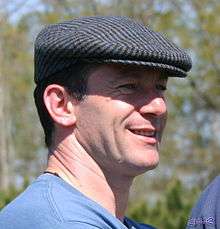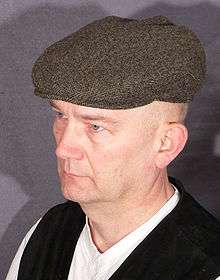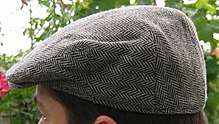Flat cap
A flat cap (sometimes "scally cap") is a rounded cap with a small stiff brim in front, originating in Britain and Ireland. The hat is known in Scotland as a bunnet, in Wales as a Dai cap, in Ireland as a paddy cap, in New Zealand as a cheese-cutter, and in the United States as a driving cap. Cloths used to make the cap include wool, tweed (most common), and cotton. Less common materials may include leather, linen, or corduroy. The inside of the cap is commonly lined for comfort and warmth.

History


The style can be traced back to the 14th century in Northern England, when it was more likely to be called a "bonnet". This term was replaced by "cap" before about 1700,[1] except in Scotland, where it continues to be referred to as a bunnet in Scots.[2]
A 1571 Act of the English Parliament was enacted to stimulate domestic wool consumption and general trade. It decreed that on Sundays and holidays, all males over 6 years of age, except for the nobility and "persons of degree", were to wear woollen caps or pay a fine of three farthings (0.75 penny, or about £0.003) per day.[3] The Act was not repealed until 1597, though by then the flat cap had become firmly entrenched as a recognised mark of a non-noble subject, such as a burgher, a tradesman, or an apprentice. The style may have been the same as the Tudor bonnet still used in some styles of academic dress.
In the 19th and early 20th centuries, when men predominantly wore some form of headgear, flat caps were commonly worn throughout Great Britain and Ireland. Versions in finer cloth were also considered to be suitable casual countryside wear for upper-class Englishmen. Flat caps were worn by fashionable young men in the 1920s. Boys of all classes in the United Kingdom wore flat caps during this period.
In the United States, the caps were worn from the 1890s. The cap grew in popularity at the turn of the 20th century and was at the time standard boys' wear. They were worn to school, for casual wear, and with suits. Flat caps were almost always worn with knicker suits in the 1910s and 1920s. Both flat caps and knickerbockers declined in popularity during the 1930s. The flat cap made its way to southern Italy in the late 1800s, likely brought by British servicemen. In Turkey, the flat cap became the main headgear for men after it became a replacement for the fez, which was banned by Mustafa Kemal Atatürk in 1925.
Academic regalia
One of the flat hats worn in academia is known as a bonnet or Tudor bonnet and derives directly from medieval headgear of the period of the original 1571 Act. It remains ceremonial wear by members of the academic community in many countries, usually as the headgear of doctoral graduates. Commonly, it has a soft, round crown and a stiff, flat brim. The bonnet is often made of black velvet and trimmed, between crown and brim, with gold cord and tassels. Some universities opt to trim their bonnets with coloured cord and tassels.
Some stylistic varieties of this bonnet are:
- The Canterbury cap is a flat-topped, soft cloth hat with a round headband deeper at the back than at the front.
- The Oxford bonnet has a black ribbon between crown and brim.
- The John Knox cap is a soft, square cap made from black velvet and worn by the doctors of certain Scottish universities, as well as Durham University in England, the University of Calgary, and Queens' University in Canada. It is also worn by the holders of higher doctorates of the University of Liverpool and Victoria University of Wellington, New Zealand.
The academic cap (mortar board), however, is more widely used in academia.
British popular culture
In British popular culture, the flat cap (or "flat hat") is typically associated with older working-class men, especially those in Northern England,[4] and the West Country, as personified by Fred Dibnah (Lancashire) and comic strip anti-hero Andy Capp (Teesside). The flat cap's strong connection with the working class and the East End of London is illustrated by Jim Branning of the television soap opera EastEnders and Del-Boy Trotter of Only Fools and Horses. Taxicab and bus drivers are often depicted wearing a flat cap, as comedically portrayed by Gareth Hale and Norman Pace's (Hale and Pace) "London cabbies" television sketches. In the BBC show Peaky Blinders, characters show their membership of the Birmingham gang by sewing razor blades into the peak of their flat caps, supposedly for use as a weapon.[5]AC/DC vocalist Brian Johnson, a native of Newcastle, customarily wears a flat cap on stage and frequently off.[6] The flat cap can also be taken to denote the upper class when affecting casualness. "A toff can be a bit of a chap as well without, as it were, losing face."[7]
In the late 20th and early 21st centuries, British public figures including David Beckham, Guy Ritchie, Richard Blackwood, and the Prince of Wales wore the flat cap.[8]
North American culture
The flat cap hat is associated in North American (chiefly US) popular culture with city newsboys (i.e., street-corner newspaper sellers), the style sometimes being called a "newsboy" or newsboy cap, sometimes referred to as a "Kangol hat" due to conflation with the brand that makes certain styles of flat caps. It is also sometimes seen worn by older non-professional or amateur golfers.
Current popularity

The style has remained popular among groups of people in the United Kingdom, Ireland, and North America. The cap is sometimes associated with older men, significantly in South Korea, but has been popular (along with the newsboy cap) among some segments of younger people, for example, in cities such as Boston and Pittsburgh with a large Irish-American population. It has appeared in the hip hop subculture, sometimes worn back-to-front or cocked to the side. It is also very common among men and women in San Francisco, California. In Turkey, it is highly popular amongst men, mostly working-class.
The English rugby league team Featherstone Rovers supporters' nickname is "the Flat Cappers", because supporters in years gone by attended matches wearing them as did most other teams' supporters.
The black leather flat cap is often combined with a patched-up sport coat or leather jacket and dark clothes (sometimes combined with a bee-striped convict’s shirt) in popular culture to depict a burglar, mugger, or robber, occasionally with a domino mask. The comic book character the Goon is based on this archetype of the flat-capped street tough from vintage cartoons and comics.
The Canadian team in the 1998 Winter Olympics wore red flat caps designed by Roots in the opening ceremony parade of nations. In addition, the US team in the 2008 Summer Olympics also wore white flat caps designed by Polo Ralph Lauren during the parade of nations.
It is commonly worn within the gopnik subculture in Russia.
See also
- British country clothing
- Skipper cap
- Coppola (cap)
- Baseball cap
References
- "Bonnet". Oxford English Dictionary (3rd ed.). Oxford University Press. September 2005. (Subscription or UK public library membership required.)
- Mairi Robinson (ed.). The Concise Scots Dictionary. Aberdeen University Press. p. 53. ISBN 0-08-028491-4.
- O'Grady, Sean (27 March 2010). "Minor British Institutions: The flat cap". The Independent. Retrieved 2017-07-24.
- Katie Wales (2006). Northern English: a cultural and social history. p. 26. Cambridge University Press ISBN 9781139457057
- Griffiths, Eleanor (2019-07-19). "Where does the name Peaky Blinders come from?". RadioTimes. Immediate Media Company Limited. Retrieved 2019-11-17.
The TV series suggests that the gang are called “Peaky Blinders” because they use the razors in their hats to blind their enemies, either by slicing the blade across their victims’ eyes or by slashing up their faces so much that they are blinded by blood.
- Anthony Bozza (2009). Why AC/DC Matters. p.54. HarperCollins, Retrieved 30 November 2011 ISBN 9780061804601
- Mather, Geoffrey. "Capped for England" BBC Radio 4, 2001.
- "If you want to get ahead, get a flat cap". Telegraph. 18 November 2016.
External links
| Look up flat cap in Wiktionary, the free dictionary. |
| Wikimedia Commons has media related to Flat caps. |
- "Cap fits for new generation". Express & Star, July 2007.
- American boys' flat caps Historical Boys Clothing
- Ivy vs. Newsboy Caps Flat Cap Information Resource